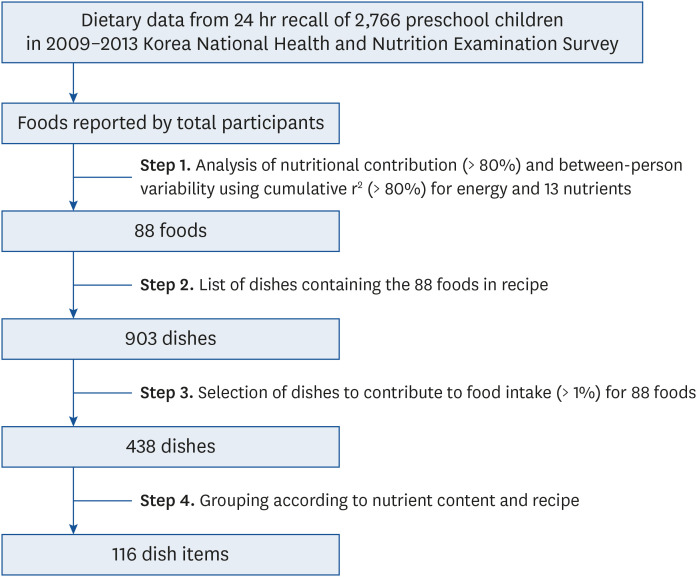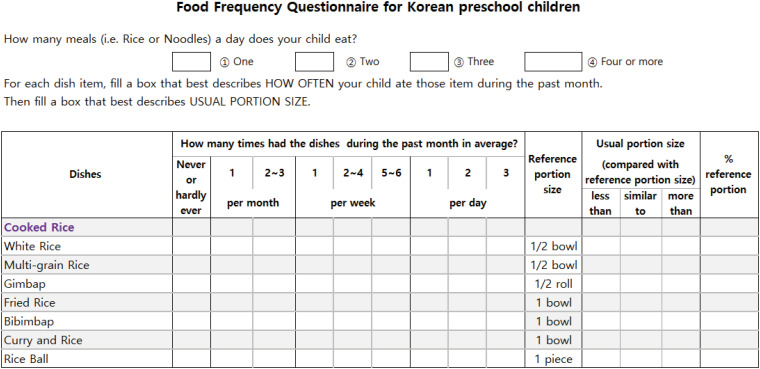Nutr Res Pract.
2020 Aug;14(4):374-383. 10.4162/nrp.2020.14.4.374.
Development of a food frequency questionnaire for dietary intake of preschool children
- Affiliations
-
- 1Center for Gendered Innovations in Science and Technology Researches (GISTeR), Korea Federation of Women's Science & Technology Associations, Seoul 06130, Korea
- 2Cancer Epidemiology Program, University of Hawaii Cancer Center, Honolulu, Hawaii 96813, USA
- 3Department of Food and Nutrition, Daejeon University, Daejeon 34520, Korea
- 4Daejeon Dong-gu Center for Children's Food Service Management, Daejeon University, Daejeon 34520, Korea
- KMID: 2504753
- DOI: http://doi.org/10.4162/nrp.2020.14.4.374
Abstract
- BACKGROUND
S/OBJECTIVES: To describe the data-based development of a food frequency questionnaire (FFQ) for dietary evaluation of Korean preschool children.
SUBJECTS/METHODS
Development of the FFQ was based on the data from 2,766 preschool children aged 1–5 years, who had completed 24-hour dietary recalls in the 2009–2013 Korea National Health and Nutrition Examination Survey. We selected the food list based on the results of nutritional contribution and between-person variability for energy and 13 nutrients. We selected 88 foods with over 80% of total contribution to each nutrient and with over 80% of accumulated r2 for each nutrient. A dish containing any of the 88 foods in the recipe was listed, and a total of 903 dishes were extracted. Among the 903 dishes, we selected 438 dishes contributing more than 1% of total consumption.
RESULTS
FFQ included 116 dish items combined from 438 dishes based on nutrient profile and recipe. Quantities of dietary intake were assessed by nine categories of frequency and portion size option. In addition, when comparing the food portions of children with the reference portion size, subjects would be asked to select one of three response categories (less, similar, and more) and then to record the amount as a percentage for the reference portion. Percentages of coverage for energy, protein, fat, and carbohydrate were 89.2%, 88.4%, 88.2%, and 89.4%, respectively.
CONCLUSIONS
The dietary intake of Korean preschool children can be assessed by this new data-based FFQ. In addition, the new instrument can be used to identify nutritional needs of target groups for planning nutrition education and strategies to improve diet. Further studies are warranted to evaluate the performance of the instrument.
Figure
Cited by 1 articles
-
Development of a semi-quantitative food frequency questionnaire for dietary intake of elementary school children: data from the Seventh Korea National Health and Nutrition Examination Survey
Minji Jung, Eunhee Ha, Oran Kwon, Hyesook Kim
Nutr Res Pract. 2023;17(4):747-761. doi: 10.4162/nrp.2023.17.4.747.
Reference
-
1. Mikkilä V, Räsänen L, Raitakari OT, Pietinen P, Viikari J. Consistent dietary patterns identified from childhood to adulthood: the cardiovascular risk in Young Finns Study. Br J Nutr. 2005; 93:923–931. PMID: 16022763.
Article2. Lanigan J, Singhal A. Early nutrition and long-term health: a practical approach. Proc Nutr Soc. 2009; 68:422–429. PMID: 19698202.
Article3. World Health Organization. Guideline: Assessing and Managing Children at Primary Health-Care Facilities to Prevent Overweight and Obesity in the Context of the Double Burden of Malnutrition: Updates for the Integrated Management of Childhood Illness (IMCI). Geneva: World Health Organization;2017.4. Livingstone MB, Robson PJ, Wallace JM. Issues in dietary intake assessment of children and adolescents. Br J Nutr. 2004; 92(Suppl 2):S213–22. PMID: 15522159.
Article5. Lovell A, Bulloch R, Wall CR, Grant CC. Quality of food-frequency questionnaire validation studies in the dietary assessment of children aged 12 to 36 months: a systematic literature review. J Nutr Sci. 2017; 6:e16. PMID: 28630693.
Article6. Livingstone MB, Robson PJ. Measurement of dietary intake in children. Proc Nutr Soc. 2000; 59:279–293. PMID: 10946797.
Article7. Willett W. Nutritional Epidemiology. 3rd ed. Oxford: Oxford University Press;2012.8. Coulston AM, Boushey CJ, Ferruzzi MG, Delahanty LM. Nutrition in the Prevention and Treatment of Disease. 4th ed. Cambridge (MA): Elsevier Academic Press;2017.9. Block G, Hartman AM, Dresser CM, Carroll MD, Gannon J, Gardner L. A data-based approach to diet questionnaire design and testing. Am J Epidemiol. 1986; 124:453–469. PMID: 3740045.
Article10. Delisle Nyström C, Henriksson H, Alexandrou C, Bergström A, Bonn S, Bälter K, Löf M. Validation of an online food frequency questionnaire against doubly labelled water and 24 h dietary recalls in pre-school children. Nutrients. 2017; 9:E66. PMID: 28098765.
Article11. Kobayashi T, Tanaka S, Toji C, Shinohara H, Kamimura M, Okamoto N, Imai S, Fukui M, Date C. Development of a food frequency questionnaire to estimate habitual dietary intake in Japanese children. Nutr J. 2010; 9:17. PMID: 20380735.
Article12. Saravia L, González-Zapata LI, Rendo-Urteaga T, Ramos J, Collese TS, Bove I, Delgado C, Tello F, Iglesia I, Gonçalves Sousa ED, De Moraes AC, Carvalho HB, Moreno LA. Development of a food frequency questionnaire for assessing dietary intake in children and adolescents in South America. Obesity (Silver Spring). 2018; 26(Suppl 1):S31–S40. PMID: 29464920.
Article13. Watson EO, Heath AL, Taylor RW, Mills VC, Barris AC, Skidmore PM. Relative validity and reproducibility of an FFQ to determine nutrient intakes of New Zealand toddlers aged 12–24 months. Public Health Nutr. 2015; 18:3265–3271. PMID: 25824599.
Article14. Korea Centers of Disease Control and Prevention. The Sixth Korea National Health and Nutrition Examination Survey (KNHANES VI). Cheongju: Korea Centers of Disease Control and Prevention;2014.15. Kang M, Shim JE, Kwon K, Song S. Contribution of foods to absolute nutrient intake and between-person variations of nutrient intake in Korean preschoolers. Nutr Res Pract. 2019; 13:323–332. PMID: 31388409.
Article16. Jung HJ, Song WO, Paik HY, Joung H. Dietary characteristics of macronutrient intake and the status of metabolic syndrome among Koreans. Korean J Nutr. 2011; 44:119–130.
Article17. Rural Development Administration. Food Composition Database Based on One Portion Size. Paju: Gyomoon;2013.18. Rural Development Administration. Food Composition Database for Children. Paju: Gyomoon;2010.19. Park MK, Noh HY, Song NY, Paik HY, Park S, Joung H, Song WO, Kim J. Validity and reliability of a dish-based, semi-quantitative food frequency questionnaire for Korean diet and cancer research. Asian Pac J Cancer Prev. 2012; 13:545–552. PMID: 22524822.
Article20. Cade J, Thompson R, Burley V, Warm D. Development, validation and utilisation of food-frequency questionnaires - a review. Public Health Nutr. 2002; 5:567–587. PMID: 12186666.
Article21. Cade JE, Burley VJ, Warm DL, Thompson RL, Margetts BM. Food-frequency questionnaires: a review of their design, validation and utilisation. Nutr Res Rev. 2004; 17:5–22. PMID: 19079912.
Article22. Fatihah F, Ng BK, Hazwanie H, Norimah AK, Shanita SN, Ruzita AT, Poh BK. Development and validation of a food frequency questionnaire for dietary intake assessment among multi-ethnic primary school-aged children. Singapore Med J. 2015; 56:687–694. PMID: 26702165.23. Kobayashi T, Kamimura M, Imai S, Toji C, Okamoto N, Fukui M, Date C. Reproducibility and validity of the food frequency questionnaire for estimating habitual dietary intake in children and adolescents. Nutr J. 2011; 10:27. PMID: 21429227.
Article24. Moghames P, Hammami N, Hwalla N, Yazbeck N, Shoaib H, Nasreddine L, Naja F. Validity and reliability of a food frequency questionnaire to estimate dietary intake among Lebanese children. Nutr J. 2016; 15:4. PMID: 26753989.
Article25. Subar AF, Midthune D, Kulldorff M, Brown CC, Thompson FE, Kipnis V, Schatzkin A. Evaluation of alternative approaches to assign nutrient values to food groups in food frequency questionnaires. Am J Epidemiol. 2000; 152:279–286. PMID: 10933275.
Article26. Kim J, Kim Y, Ahn YO, Paik HY, Ahn Y, Tokudome Y, Hamajima N, Inoue M, Tajima K. Development of a food frequency questionnaire in Koreans. Asia Pac J Clin Nutr. 2003; 12:243–250. PMID: 14505984.
- Full Text Links
- Actions
-
Cited
- CITED
-
- Close
- Share
- Similar articles
-
- Assessment of Dietary Intake of Preschool Children in Busan : Assessment Based on Food Group Intake
- The Association between Maternal Nutrition Knowledge, Dietary attitudes, and Dietary Behaviors Related to Sugar Intake, and Sugar Intake Reduction in Preschool Children
- Sodium-related Eating Behaviors of Parents and Its Relationship to Eating Behaviors of Their Preschool Children
- Fast Food Intake Frequency and Health Practices
- Evaluation of a Nutrition Education Program Designed to Reduce Sugar Intake in Preschool Children



